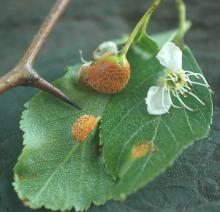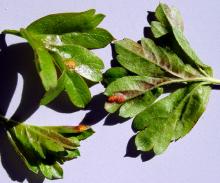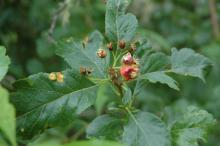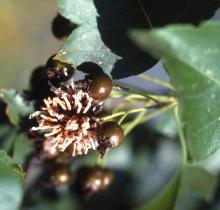See:
Juniper (Juniperus spp.) - Rust
Cause Several fungi in the genus Gymnosporangium cause rusts on hawthorn. G. clavariiforme (alternate host juniper) and G. libocedri (alternate host incense-cedar) have been reported from Oregon; from Washington, G. clavipes (alternate host cedar and juniper); and for all states including Idaho, G. bethelii (alternate host juniper) . The rusts are throughout North America wherever perennial hosts (mainly juniper) grow near the deciduous hosts (members of the rose family, including hawthorn, Amelanchier, cotoneaster, apple, pear, quince, and Sorbus). Spores that form on hawthorn are usually shed in mid- to late summer and infect juniper. Juniper galls release orange spores in spring, which are blown to nearby hawthorns and other hosts. These spores infect newly opening leaves and tender young fruit. Spore stages produced on the junipers or cedars infect only hawthorn and members of the rose family in early spring but can be produced repeatedly over 2 to 3 years from one infection.
Symptoms Leaves, fruit, and sometimes twigs are infected, causing conspicuous leaf spots (bright yellows to oranges) and defoliation as well as fruit and twig deformities. When infections on hawthorn mature, hair-like (tubular) spore-bearing structures (aecia) extrude from the tissue. Juniper infections usually appear as swellings or galls on twigs and produce orange spores in spring.
Cultural control
- Check the vicinity for infected juniper; if they have no value, remove them.
- If you are growing both hosts as crops, separate them as widely as possible. Separating hosts by 0.5 to 2 miles has been recommended.
- Prune out any visible galls or swellings on juniper before spring and remove visible infections on hawthorn or other deciduous hosts before they sporulate in summer.
Chemical control Protect new growth when infections on juniper are sporulating in spring, sometime between mid-March and mid-May depending on weather and location.
- Armada 50 WDG at 3 to 9 oz/100 gal water. Do not use a silicone-based surfactant. Not for nursery or greenhouse use. Group 3 + 11 fungicide. 12-hr reentry.
- Bonide Fung-onil Multi-purpose Fungicide at 2.25 teaspoons/gal water. H
- Compass 50 WDG at 2 to 4 oz/100 gal water. Do not use with organosilicate products. Group 11 fungicide. 12-hr reentry.
- Concert at 9 to 17 fl oz/100 gal water. May cause injury to buds, blooms or tender new growth. Landscape use only. Group 3 + M5 fungicide. 12-hr reentry.
- Daconil Weather Stik at 1.38 pints/100 gal water. Group M5 fungicide. 12-hr reentry.
- Eagle 20 EW at 6 to 12 fl oz/100 gal water. Group 3 fungicide. 24-hr reentry.
- Mancozeb-based products. Group M3 fungicides. 24-hr reentry.
- Fore 80 WP at 1.5 lb/100 gal water plus a spreader-sticker.
- Protect DF at 1 to 2 lb/100 gal water plus 2 to 4 oz spreader-sticker.
- Myclobutanil 20 EW T&O at 6 to 12 fl oz/100 gal water plus spreading agent. May observe a PGR effect. Group 3 fungicide. 24-hr reentry.
- Phyton 27 at 1.5 to 2.5 oz/10 gal water. Group M1 fungicide. 48-hr reentry.
- Propiconazole-based products. Group 3 fungicides.
- Banner MAXX at 2 to 4 fl oz/100 gal water. 12-hr reentry.
- Infuse Systemic Disease Control at 0.5 Tbsp/gal water. H
- ProCon-Z at 2 to 4 oz/100 gal water. 24-hr reentry.
- ProStar 70 WG at 3 to 6 oz/100 gal water. Group 7 fungicide. 12-hr reentry.
- Spectracide Immunox Multi-Purpose Fungicide Spray Concentrate for Gardens at 1 fl oz/gal water. Group 3 fungicide. H
- Spectro 90 WDG at 1 to 2 lb/100 gal water. Group 1 + M5 fungicide. 12-hr reentry.
- Terraguard SC at 2 to 8 fl oz/100 gal water. Group 3 fungicide. 12-hr reentry.
- Tourney EZ at 1 to 4 oz/100 gal water. Group 3 fungicide. 12-hr reentry.
Reference Pirone, P.P. 1978. Diseases and Pests of Ornamental Plants, 5th ed. New York: John Wiley & Sons, Inc.






